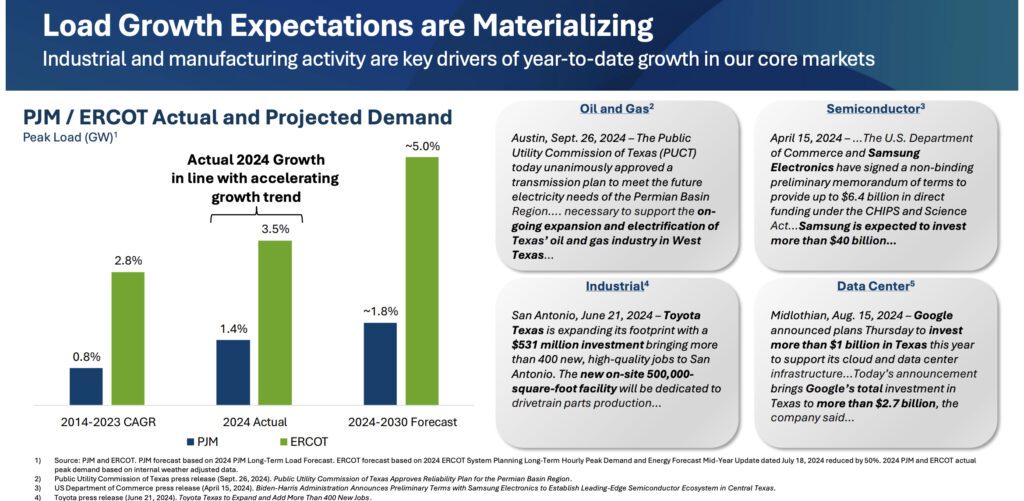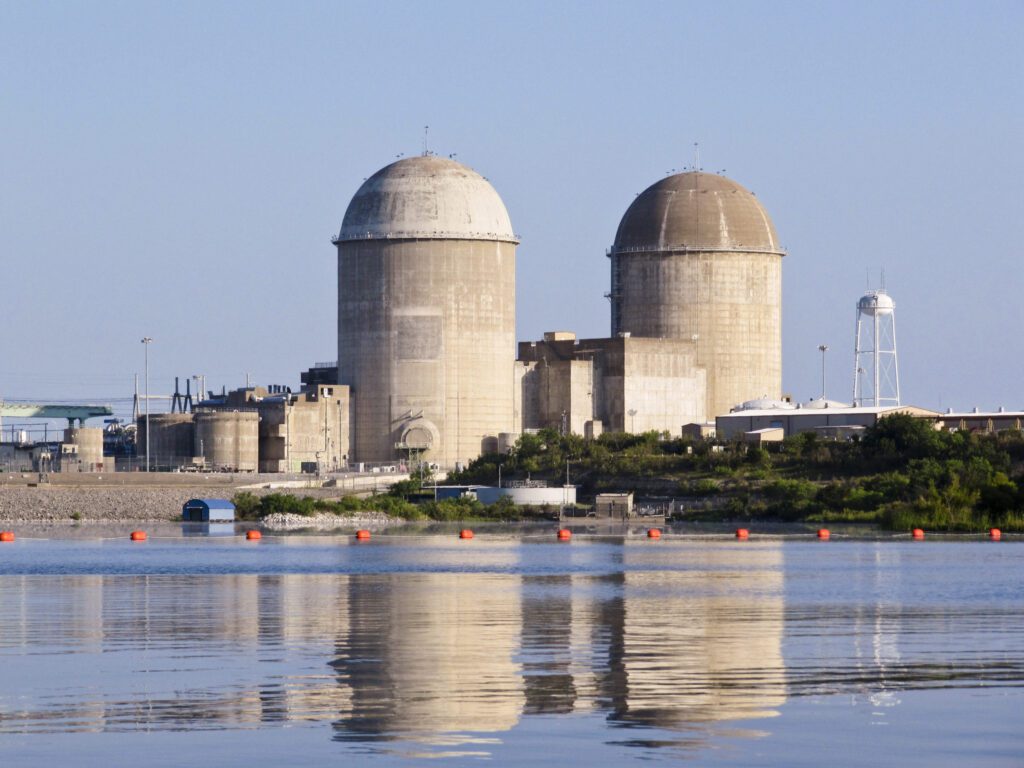Vistra in Talks to Expand Power for Data Centers Through Nuclear, Gas Options
Vistra is pursuing deals with data center developers in Texas and the PJM region to address the industry’s energy needs at multiple sites, executives revealed during the company’s third-quarter earnings call on Nov. 7.
The Texas-based competitive generator has entered discussions with some of the largest, unnamed data center operators to increase output at its nuclear sites, including its 2.4-GW Comanche Peak nuclear plant near Dallas in Texas. It is also in discussions with two “particular large companies” about building new gas power plants to support a data center project directly, and it is exploring partnerships for co-location opportunities at several of its existing gas-fired plants in both PJM and the Electric Reliability Council of Texas (ERCOT), said Stacey Doré, Vistra’s head of Strategy, during the call.
“We are currently pursuing deals at multiple sites in our portfolio. We’re also having some early conversations with some of the developers about a kind of portfolio approach where, with one customer, we might be able to pursue co-location deals at multiple sites and combine that with even building some new generation,” Doré said.
“We’re in pretty detailed customer discussions at some of our nuclear sites. There’s a lot of interest, obviously, in the nuclear side,” she noted. “But we have ongoing conversations with several different development companies, about a handful of our gas sites, both in PJM and in ERCOT. And we’re in early discussions with some of the hyperscalers about nuclear uprates and some new build,” she said.
Executives on Thursday noted load growth projections in both PJM and ERCOT are trending upward. The many drivers of power demand growth include “the build-out of large chip manufacturing facilities, partially due to the CHIPS Act the electrification of oil and gas load in the Permian Basin of West Texas, the reshoring of industrial activity and, of course, the build-out of data centers,” said Vistra president and CEO Jim Burke.
“Some grid operators have already raised their expectations for demand growth through midyear updates while numerous industry observers have published forecasts reflecting an acceleration in power demand across the country,” he said. “We believe the level of growth across both markets confirms our view that load growth is already occurring, and we expect it to continue.”

A Focus on Comanche Peak
Doré revealed that discussions about Comanche Peak, one of Vistra’s four nuclear plants, have been ongoing “for some time.” Vistra is actively also looking to co-locate load at the 1.8-GW Beaver Valley nuclear plant. “It’s already been studied that a load could be co-located there without negative impact to the grid,” she noted.
However, interest has been prevalent for the Texas plant “because of the speed-to-market advantage it has.” ERCOT is one of the “fastest interconnection processes in the country,” she noted. “And the state prides itself on that, with the [transmission and distribution utilities (TDUs)] and ERCOT working together to get load interconnected as an advantage in Texas.”

She also highlighted ERCOT’s regulatory advantage, noting that it operates outside Federal Energy Regulatory Commission (FERC) jurisdiction, which shields it from certain federal rulings. On Friday, FERC notably rejected an amended interconnection service agreement (ISA) that would have enabled expanded co-located load for an Amazon Web Services (AWS) data center connected to the 2,520-MWe Susquehanna nuclear plant in Pennsylvania, citing concerns over grid reliability and equitable cost allocation. Talen Energy, the plant’s majority owner, intends to proceed with the current arrangement, supplying Amazon with up to 300 MW under the existing ISA.
While some industry observers worry that FERC’s decision could dampen similar co-location deals within PJM’s transmission territory, others have questioned FERC’s stance on co-location in general. “So certainly, the fact that ERCOT is not subject to the FERC jurisdiction and the order that came out last Friday has continued to make Comanche Peak an attractive site, but it was before the FERC order as well,” Doré said.
However, because discussions for Comanche Peak involve multiple parties, timing is uncertain, she said. “In terms of timing, it’s hard to say exactly when we could conclude discussions on that site because, again, there’s a lot of work to be done. There’s a lot of stakeholders to involve—not just ERCOT, policymakers, Oncor, who is the local TDU at that site, but local officials as well.” She added: “We’re well into that, deep into that process and continuing to pursue that opportunity, and it’s a great opportunity for Vistra and for customers.”
Asked to elaborate on the scale and diversity of approaches data centers might have, given high demand forecasts, Doré noted the discussions “take a number of forms with multiple companies around multiple sites. And, of course, we’re including stakeholders in those conversations, as well from policymakers to the applicable transmission distribution utilities. As we’ve said before, the diligence process for these deals takes a long time. It’s an intense effort because these are very long-term commitments to purchasing power,” she said.
A Valuable Capital Return Program
Vistra received the Nuclear Regulatory Commission’s (NRC) approval in July 2024 to extend the operation of Comanche Peak Nuclear Power Plant through 2053, an additional 20 years beyond its original licenses. The company’s Beaver Valley Nuclear Power Plant units 1 and 2 in Pennsylvania are licensed through 2036 and 2047, and Davis-Besse in Ohio is licensed through 2037. Perry Nuclear Power Plant in Ohio filed its application for renewal through 2046 in 2023 and is currently in the NRC review process.
The company holds a generating capacity of about 41 GW, a portfolio that includes natural gas, coal, nuclear, solar, and battery energy storage facilities. In May 2024, Vistra announced plans to add up to 2 GW of dispatchable natural gas capacity across west, central, and north Texas. Projects include 860 MW of new peaking plants in west Texas to support regional power demand, particularly in the oil and gas sector; a 600 MW natural gas repowering of the Coleto Creek coal plant near Goliad, set for 2027 retirement; and upgrades at existing gas plants to add over 500 MW of summer capacity and 100 MW of winter capacity.
In addition, in the third quarter, the company secured two power purchase agreements at new solar facilities, totaling over 600 MW, including a 200 MW agreement with Amazon in Texas and a 405 MW deal with Microsoft in Illinois.
At the same time, Vistra is actively growing its ownership interest in nuclear. In September, it entered into an agreement to acquire the entire 15% minority interest in its Vistra Vision subsidiary, which will make Vistra the sole owner of the carbon-free assets. The minority interest, currently held by affiliates of Nuveen and Avenue Capital, is valued at a net present cash purchase price of $3.085 billion and will be paid in installments through 2026. “This acquisition will increase our nuclear ownership by ~970 MW and our solar and energy storage ownership by ~200 MW,” the company said.
Challenging Markets
On Thursday, CEO Burke said the company will continue to make progress on its plans to build 2 GW of gas-fired capacity “as we evaluate the implementation of market reforms and the trajectory of forward prices.” The company’s capital return program “continues to deliver value, having returned over $5.4 billion since the program was originally announced in November 2021. We look forward to delivering on our 2024 goals and beginning to execute on our 2025 priorities,” he said.
The company is fielding lucrative prospects, he suggested. In Texas, Vistra made the shortlist earlier this year for one of its two 440-MW projects proposed for the Permian Basin under the Texas Energy Fund (TEF) In-ERCOT Loan Program, a state program that will disburse $5.38 billion in loaned funds to support dispatchable generation, he noted. However, Burke noted that the program’s $1 billion cap on the Performance Credit Mechanism (PCM) could limit overall resource investment, while legislative challenges and ancillary service uncertainties add further complexities. Burke said that while Vistra remains committed to advancing its TEF-backed peaker projects, it also has “off ramps” if “market developments that we need to see don’t occur. And we hope that’s not the case because we’d like to bring those peakers [online] but we’ve got to make economic decisions. And we’re still not there yet,” he said.
PJM remains an attractive market, Burke noted. “A capacity market construct in PJM is something that I think creates a real opportunity to send a price signal and encourage investment, whether that’s some assets that are on the grid to not retire or to bring new assets and obviously meeting the load growth that PJM is now forecasting. That market design does not exist in Texas,” he noted.
While Burke on Thursday acknowledged challenges posed by FERC’s Friday ruling for data center co-location, he said that Vistra sees multiple paths forward to resolve any issues as it relates to that project and other similar projects. “FERC’s ruling was narrowly based on the commission’s view that the ISA failed to meet previous FERC precedent, leaving the door open for a refiling of a streamlined ISA,” he said. “Nothing about FERC ruling prevents us or other generators from contracting with customers who are seeking to co-locate for their needs. We will need to address open issues and find the path to FERC approval of interconnection service agreements, which we believe is doable.”
“As we’ve stated before, there will be many large load opportunities that will have a variety of configurations, whether located next to a generation facility or in a more traditional front of the meter configuration,” he added. “We don’t believe there will be a one-size-fits-all approach to this—and there shouldn’t be as customer needs will vary.”
—Sonal Patel is a POWER senior editor (@sonalcpatel, @POWERmagazine).